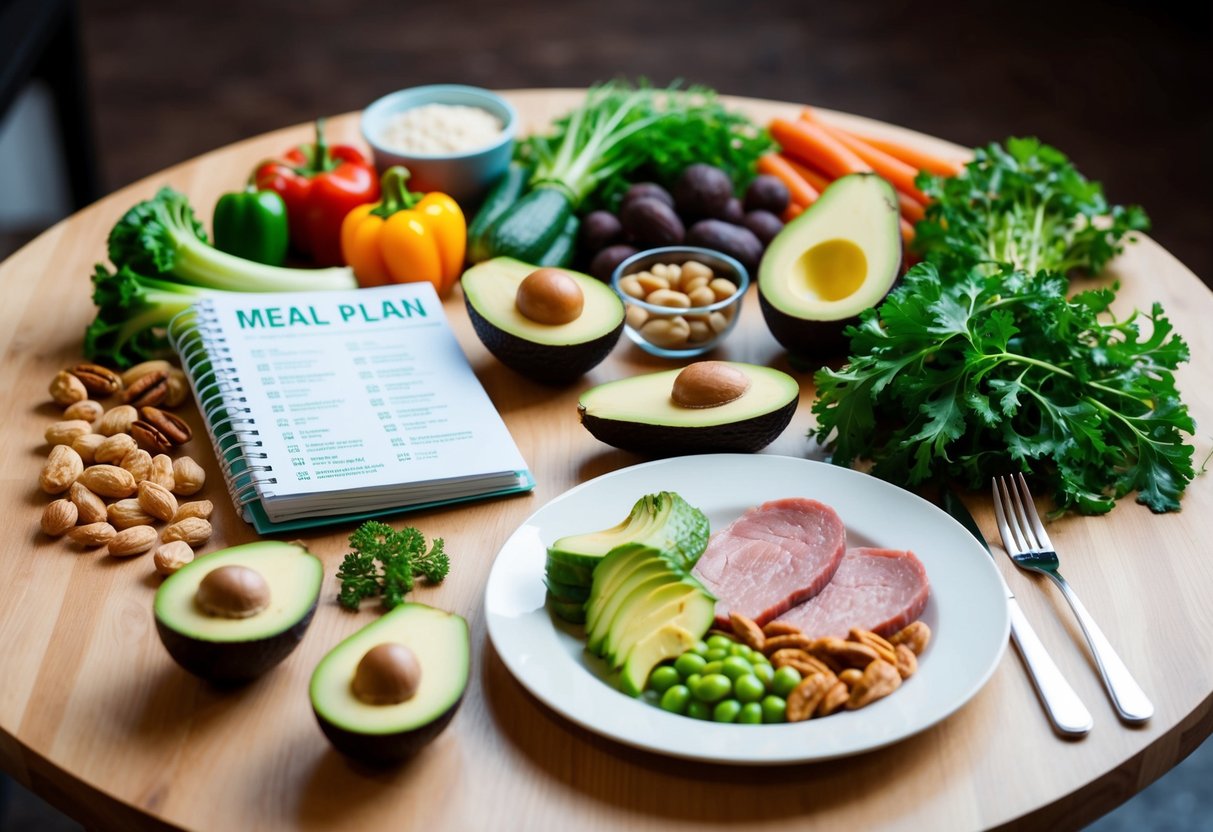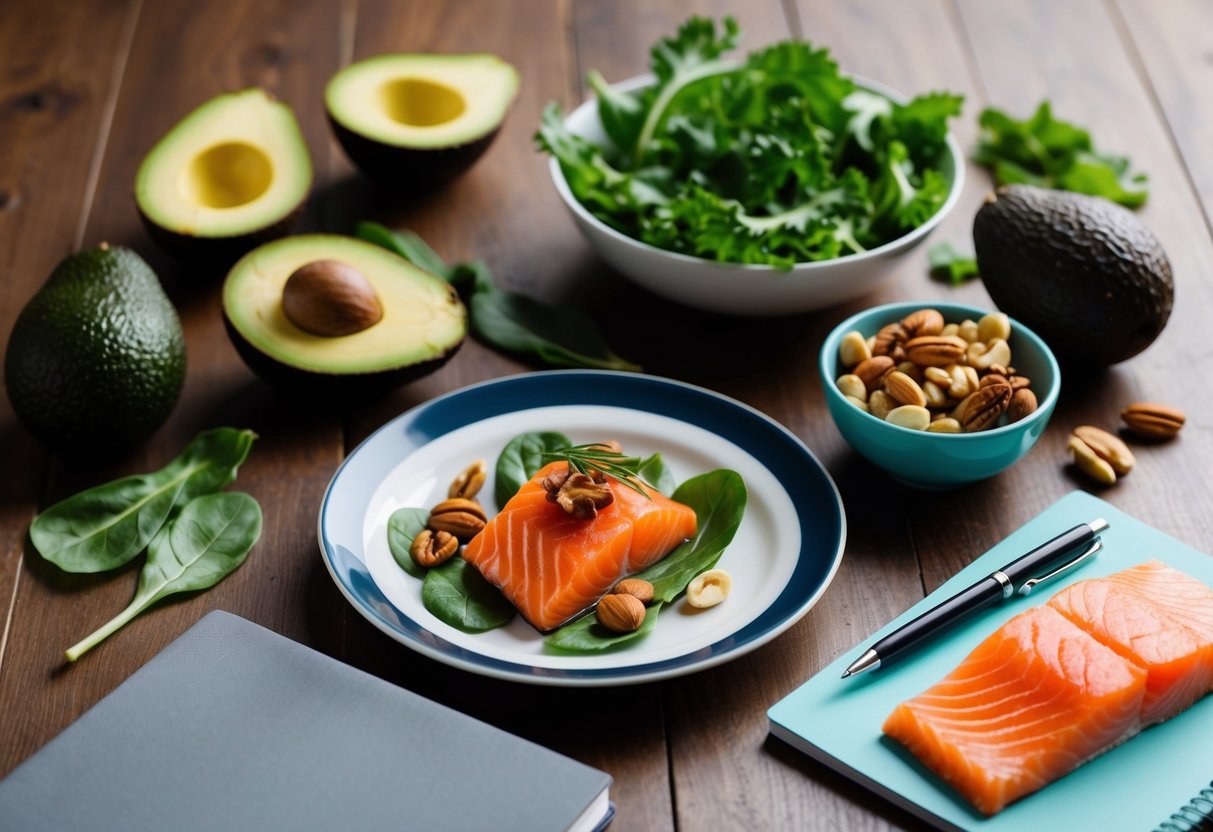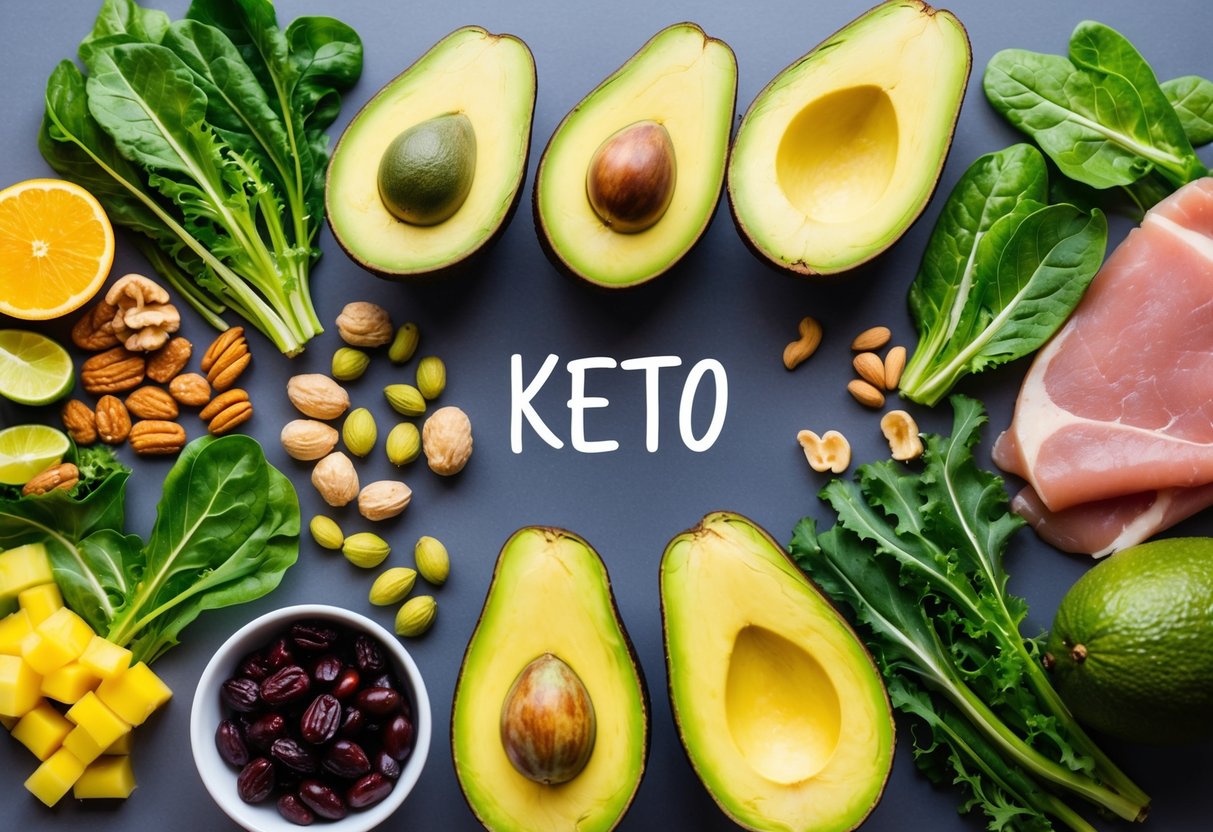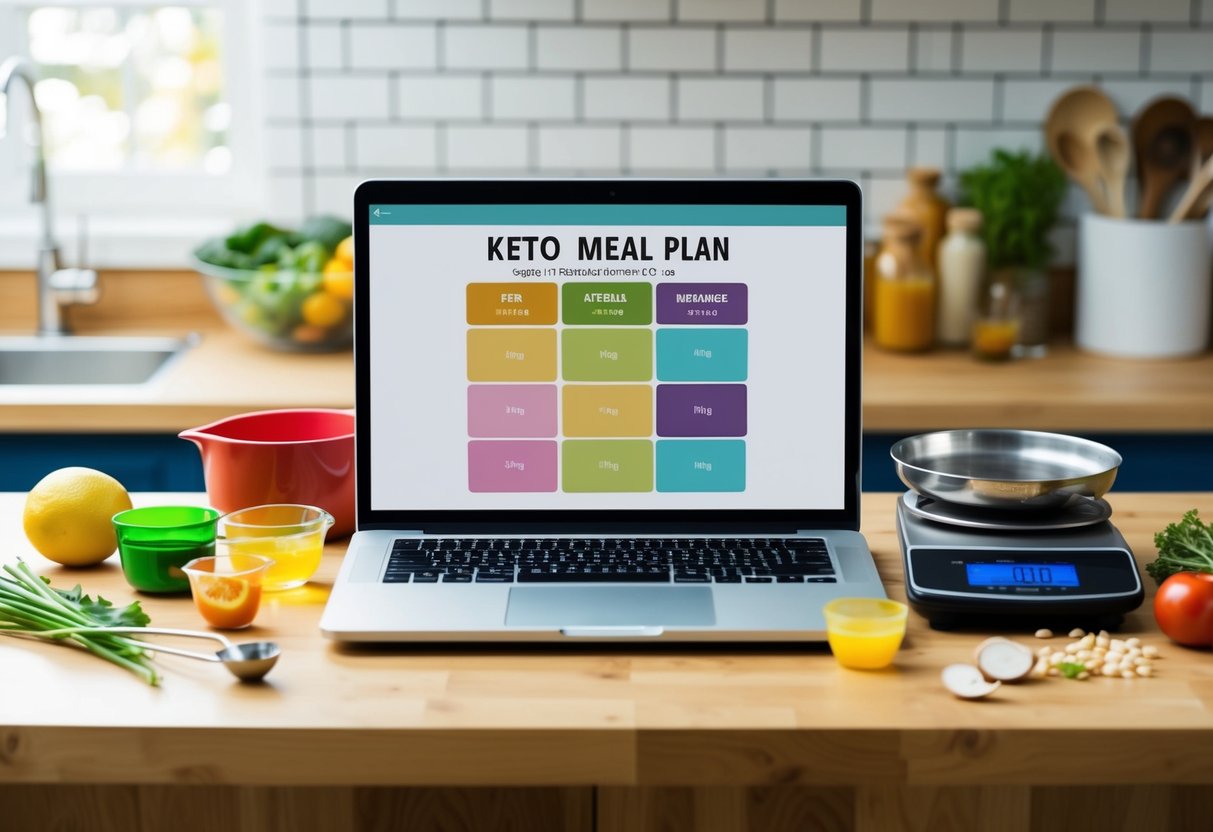Free Keto Meal Plan for Beginners: Easy Recipes and Tips to Start Your Journey
This post may contain affiliate links. If you purchase through these links, I may earn a small commission at no extra cost to you. LEARN MORE.
Embarking on a keto journey can be daunting for beginners navigating through dietary changes and nutritional information.
A free keto meal plan for beginners offers an accessible starting point, guiding beginners through a structured approach to this low-carb, high-fat diet.
By focusing on accommodating delicious recipes and providing a clear pathway to meal planning, anyone can seamlessly integrate the benefits of keto into their daily routine.

The keto diet works by drastically reducing carbohydrate intake and replacing it with fat, allowing the body to enter a state of ketosis, where it becomes efficient at burning fat for energy.
This metabolic shift can lead to multiple health benefits, including weight loss and improved blood sugar control.
Utilizing a well-organized meal plan helps beginners understand the core fundamentals and easily adopt new eating habits while enjoying diverse meals.
As individuals start their keto journey, they can find added support in practical tips and resources, ensuring adherence and progress.
Whether it’s through tailored meal plans or community advice, the right tools set the foundation for a successful keto lifestyle. Beginners no longer have to navigate this transformative diet change alone.
Key Takeaways
- Free meal plans simplify the start of a keto diet.
- Keto diet focuses on low carbs, high fats for health benefits.
- Support and resources enhance the keto journey.
Starting Your Keto Journey

Embarking on a keto diet involves learning its fundamental principles and understanding how to effectively begin. It requires adhering to specific dietary guidelines and rules to achieve ketosis, the metabolic state essential for this diet’s success.
Understanding the Basics
The keto diet focuses on high-fat, low-carbohydrate intake, which transitions the body into a metabolic state called ketosis.
In ketosis, fat is used as the primary energy source, rather than carbohydrates.
Carbohydrates are usually limited to just 20-50 grams per day, while fats and proteins are increased.
This plan may include foods like avocados, nuts, seeds, and meats.
The primary goal is to reduce insulin levels and promote fat burning.
Knowing which foods to include and avoid is crucial for beginners to adapt and thrive on the keto diet.
How to Start Keto Diet
Starting a keto diet requires preparation and planning.
Beginners should kick off their journey by creating a customizable meal plan.
Focusing on whole, unprocessed, low-carb foods is important.
Tracking carbs, fats, and proteins can be done using apps or journals, which will help in meal planning and monitoring progress.
Additionally, transitioning gradually may help in avoiding “keto flu”, a set of symptoms some experience due to initial carb withdrawal.
Stocking up on keto-friendly foods and gradually lowering carb intake allows the body to adjust more smoothly.
Hydration is important, as well as ensuring adequate electrolyte intake to maintain balance.
Keto Diet Rules
There are specific rules to follow to ensure success on a keto diet.
Consistency in reducing carb intake to encourage ketosis is vital.
This involves cutting back on high-carbohydrate foods like bread, pasta, and sugary snacks.
Increasing healthy fats such as those from olive oil, butter, and coconut oil is essential for energy.
Maintaining balanced macronutrients by keeping protein moderate helps in preventing excess stored energy from being used as fuel.
Keto dieters should also focus on staying hydrated and replenishing electrolytes like sodium, potassium, and magnesium.
Regular monitoring and adjustments keep the dieter informed and aligned with their health goals.
Keto Diet Meal Planning

Planning meals on a keto diet involves selecting low-carb ingredients and creating balanced meals that fit within the dietary macronutrient guidelines. Understanding the basics of keto-friendly foods, creating a tailored meal plan, and possibly personalizing it to fit individual needs ensures a seamless transition to this lifestyle.
Keto Diet Food List
A well-curated keto diet food list is essential for staying within the carbohydrate limits that characterize this eating plan.
Key foods include meats, fatty fish, eggs, and low-carb vegetables such as spinach and kale.
Healthy fats from sources like avocado and olive oil are vital.
Nuts and seeds can be added for variety.
Dairy products like cheese and butter also fit well into many keto plans.
For those following a vegetarian keto diet plan, incorporating tofu and tempeh can be beneficial.
Avoiding high-carb items like grains and sugars is crucial for success on the keto diet, ensuring energy comes from healthy fats.
Keto Diet Meal Plan
Crafting a simple keto diet meal plan involves meal prepping and portion control to maintain ketosis.
A typical 7-day keto diet plan might start with breakfast options like eggs with spinach or a chia seed pudding made with almond milk.
Lunches could include a salad with grilled chicken, while dinners might feature dishes such as salmon with a side of broccoli.
Snacks can include cheese cubes or a handful of almonds.
Incorporating this kind of structured meal plan reduces the stress of daily decision-making.
Grocery lists tailored to the meal plan help in adhering to keto-friendly foods while shopping, ensuring that each meal remains within the ketogenic guidelines.
Custom Keto Meal Plan
For those with specific dietary preferences or restrictions, a custom keto plan can provide a tailored approach.
Custom meal plans take individual needs into account, such as those of people requiring a clean keto diet or a vegetarian option.
They allow the incorporation of preferred foods and help to accommodate different lifestyles, whether for a beginner easing into a new routine or someone on a 60-day keto diet plan.
Using tools and apps that generate personalized meal plans and shopping lists can streamline this process.
A well-executed custom meal plan supports sustained engagement with the keto diet by fitting seamlessly into one’s daily routine.
Keto Nutrition & Foods

Embarking on a keto journey involves understanding what to eat and how to balance nutritional needs. This approach focuses on low-carb, high-fat foods, managing macronutrient intake, and exploring creative snack and dessert options.
Foods to Eat on Keto Diet
A keto diet emphasizes low-carb and high-fat foods.
By significantly reducing carbohydrate intake, the body enters a state known as ketosis.
Foods like meat, fish, eggs, and cheese become staples, providing essential proteins and fats.
Vegetables that are low in carbs, such as leafy greens, zucchini, and broccoli, are encouraged.
Healthy fats like olive oil, avocado, and butter enhance meal richness without adding carbs.
Nuts and seeds offer snacking alternatives that align with keto goals.
Managing Macros and Calories
Balancing the three main macronutrients — carbohydrates, fats, and proteins — is crucial for a successful keto diet.
Typically, the keto ratio involves about 70% of calories from fat, 20% from protein, and 5-10% from carbohydrates.
Adjusting these percentages might be necessary depending on individual goals and using a keto diet calculator can help track them.
Being calorie-conscious helps prevent overeating.
While the main focus is on macros, tracking total caloric intake ensures weight loss or maintenance.
Understanding portion sizes and utilizing digital food scales can assist in maintaining appropriate consumption levels.
Keto Diet Snacks and Desserts
Snacks and desserts on a keto diet can be both satisfying and low-carb.
Options like cheese, hard-boiled eggs, and avocado slices are quick go-tos for snacks.
When it comes to desserts, ingredients such as almond flour, coconut flour, and sugar substitutes allow for indulgent treats.
Recipes might include keto cheesecakes, chocolate mousse, and coconut fat bombs.
Creativity in using keto-friendly ingredients helps maintain dietary adherence while enjoying variety.
Practical Keto Lifestyle Tips

Navigating a keto lifestyle during social events and choosing appropriate beverages can make staying on a low-carb diet more manageable. This section provides insights into making keto-friendly choices in these scenarios.
Eating Out and Social Events
When dining out or attending social gatherings, individuals can maintain their keto diet by choosing meals that focus on protein and vegetables.
Opt for dishes such as grilled meats, salads with olive oil dressing, and side dishes like steamed broccoli or cauliflower.
Requesting modifications, like swapping out potatoes for extra vegetables, enhances keto compatibility.
Reading the menu carefully and preparing a mental list of potential choices can be beneficial.
Social events may present more challenges.
Sticking to cheese, olives, and nuts can help maintain ketosis when only snacks are available.
Bringing a keto-friendly dish can also ensure there are suitable options without compromising dietary goals.
Alcohol and Beverages
Incorporating alcohol into a keto lifestyle requires cautious choices.
As a rule of thumb, pure spirits like vodka, gin, or whiskey have zero carbs and are preferable over beer or sugary cocktails.
For mixers, opting for soda water with a twist of lime is ideal.
Diet sodas, such as Diet Coke, can be consumed on keto, though moderation is advised due to artificial sweeteners.
When selecting beverages, check labels for hidden sugars even in drinks marketed as “diet” or “low-carb.”
Hydration is key, so drink plenty of water alongside other beverages to support overall health and wellbeing.
Monitoring Progress and Adjusting

Monitoring progress is crucial for anyone on a keto diet to ensure they are on track. Individuals can achieve better results by tracking success and making necessary meal plan adjustments.
Track Your Success
Consistently tracking keto diet results is essential for evaluating progress.
Weight loss can be measured using a scale, but it’s also beneficial to track body measurements, such as waist, hip, and chest circumference. This offers a more comprehensive view of changes.
Many prefer tracking ketone levels to confirm they’re in ketosis, utilizing urine strips, blood tests, or breath analyzers.
These tools provide feedback, helping individuals understand how their body is responding to the diet.
Utilizing keto diet reviews and testimonies can offer motivation and insights, but personal tracking remains the most reliable method.
Online apps and journals can facilitate easy record-keeping, making it simple to track food intake and physical changes.
Adjusting Your Meal Plan
Adjustments to the 8 week custom keto diet plan can optimize outcomes. For instance, if weight loss stalls, modifying macro ratios, such as increasing fat or reducing carbs, might be necessary.
Experimenting with meal timings and fasting can also trigger further progress.
Individuals may benefit from a customized keto diet plan tailored to their unique preferences and dietary needs. This can help overcome plateaus and maintain enthusiasm for the plan.
Regularly consulting with a nutritionist or dietician can provide expert guidance, ensuring that any meal plan changes support health goals effectively.
It’s important to stay flexible and responsive to one’s body needs while maintaining the diet’s core principles. The balance between flexibility and consistency often proves crucial for success.
Support and Resources
Navigating a keto diet can be more manageable with the right tools and community support. Utilizing a keto diet app and engaging with keto diet communities can significantly enhance the experience and provide ongoing motivation.
Using a Keto Diet App
A keto diet app is a valuable tool for both beginners and veterans of the keto lifestyle. It helps track macronutrients, ensuring daily carbohydrate intake is kept below the necessary levels for ketosis.
Apps often offer features like custom meal plan creators, shopping lists, and recipe ideas tailored to individual dietary preferences and restrictions.
With detailed logging capabilities, users can document their meals and monitor their progress. These apps frequently provide nutritional information and have databases of keto-friendly foods.
Many apps also allow for syncing across devices, so progress and dietary tracking can be accessed on-the-go.
Finding Keto Diet Communities
Joining a keto diet community can offer moral support and practical advice. These communities frequently exist on social media platforms, forums, and keto diet blogs, where members share experiences, recipes, and tips.
Engaging in these groups can also expose individuals to diverse perspectives on tackling challenges and sustaining lifestyle changes.
Community interaction often includes success stories and custom keto diet reviews, serving as motivation. It’s not uncommon for these communities to offer book recommendations and resources for continued learning.
They also often discuss reviews on plans like the 8-week custom keto diet, providing firsthand insights into its effectiveness and adaptability.
Frequently Asked Questions
Beginning a ketogenic diet involves understanding basic guidelines, optional printable meal plans, and strategies for effective weight loss. It’s important to find specialized meal plans for seniors or women and utilize keto diet tracking apps for optimal results.
What are the basic guidelines for starting a ketogenic diet as a beginner?
Initiating a ketogenic diet requires reducing carbohydrate intake significantly while increasing fats and moderate protein.
Beginners often aim for a daily intake where carbs constitute about 5-10% of total calories, while fats make up 70-80%, and proteins cover the remaining percentage. Consulting with a healthcare provider before starting is advisable.
Are there any printable 30-day ketogenic meal plans available at no cost?
Several websites offer free printable 30-day ketogenic meal plans that provide a structured approach to meal planning. These resources often include grocery lists and meal prep tips to help beginners transition smoothly into a ketogenic lifestyle without incurring additional costs.
How can one lose weight effectively on a ketogenic diet, specifically aiming to drop 20 pounds?
To lose weight effectively on a ketogenic diet, maintaining a caloric deficit is crucial. Consistent tracking of carb intake and regular exercise can enhance weight loss.
Hydration and sufficient electrolyte intake support the body during this metabolic shift. Monitoring progress through regular check-ins helps maintain motivation and adjust strategies as needed.
Can you suggest a keto meal plan tailored for seniors or women?
Keto meal plans for seniors or women may focus on nutrient-dense foods to support overall health, such as leafy greens, healthy fats, and adequate protein.
Adjustments might be necessary to accommodate different nutritional needs or medical conditions. Consulting with a nutritionist could provide personalized guidance.
What are the essential rules one should follow when embarking on a keto diet?
Essential rules include minimizing carbohydrate consumption, ensuring sufficient fat intake, and avoiding processed foods and sugars.
It’s also important to stay hydrated, include a variety of nutrient-rich foods, and periodically monitor ketone levels to ensure the body remains in ketosis.
How do I find a reliable and free keto diet tracking app?
Several free apps are designed to track keto diet progress. They offer features like carb counting, meal logging, and recipe suggestions.
Popular options are available in app stores. User reviews and ratings guide users to those with reliable features.
Consistent use of these apps can provide valuable insights into dietary habits and progress.


